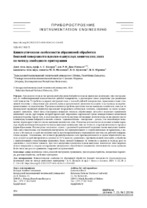| dc.contributor.author | Козерук, А. С. | |
| dc.contributor.author | Диас Гонсалес, Р. О. | |
| dc.contributor.author | Филонова, М. И. | |
| dc.contributor.author | Кузнечик, В. О. | |
| dc.contributor.author | Юринок, В. И. | |
| dc.coverage.spatial | Минск | ru |
| dc.date.accessioned | 2024-04-12T06:50:51Z | |
| dc.date.available | 2024-04-12T06:50:51Z | |
| dc.date.issued | 2024 | |
| dc.identifier.citation | Кинематические особенности абразивной обработки боковой поверхности плоско-выпуклых конических линз по методу свободного притирания = Kinematic Features of Abrasive Processing of Lateral Surface of Flat-Convex Conical Lenses Using Free Rubbing Method / А. С. Козерук [и др.] // Наука и техника. – 2024. – № 2. – С. 114-120. | ru |
| dc.identifier.uri | https://rep.bntu.by/handle/data/141828 | |
| dc.description.abstract | Предложена технология трехопорной абразивной обработки плоско-выпуклых конических линз инструментом со стабилизированной плоскостностью рабочей поверхности, и рассмотрена схема устройства для реализации этой технологии. Устройство содержит инструмент-диск с плоской рабочей поверхностью, правильник в виде стеклянной пластины с отверстиями для деталей, привод вращательного движения последних и вал привода возвратно-вращательного их перемещения. При использовании устройства крепление плоско-выпуклых конических линз для их последующей групповой обработки происходит посредством оптического контакта, основанного на силах молекулярного сцепления. Такой метод блокировки повышает точность обработанных деталей и исключает применение наклеечной смолы, при нагреве которой происходит загрязнение окружающей среды канцерогенными веществами фенольной группы. Кроме того, в конструкцию устройства введены специальные компенсаторы, позволяющие свести к минимуму влияние вибраций в системе «станок – приспособление – инструмент – деталь», что способствует повышению параметров точности плоско-выпуклых конических линз. Изложены результаты исследования влияния характера обработки боковой поверхности плоско-выпуклых конических линз на точность и производительность процесса формообразования. Рассмотрены следующие случаи: с различной ориентацией вершины плоско-выпуклых конических линз относительно оси симметрии инструмента, без принудительного и с принудительным их вращением, с выходом и без выхода за край инструмента при возвратно-вращательном перемещении заготовок по рабочей поверхности последнего. Установлено, что точность формообразования и его производительность в случае обработки без выхода деталей за край инструмента в среднем на 30 % выше по сравнению с противоположной ситуацией, а обработка с принудительным относительным вращением блока деталей повышает их точность в среднем в полтора раза по сравнению с отсутствием такового, при этом внутренняя ориентация плоско-выпуклых конических линз (вершина конуса направлена в сторону оси вращения инструмента) способствует повышению интенсивности съема припуска более чем в два раза по сравнению с наружной их ориентацией. | ru |
| dc.language.iso | ru | ru |
| dc.publisher | БНТУ | ru |
| dc.title | Кинематические особенности абразивной обработки боковой поверхности плоско-выпуклых конических линз по методу свободного притирания | ru |
| dc.title.alternative | Kinematic Features of Abrasive Processing of Lateral Surface of Flat-Convex Conical Lenses Using Free Rubbing Method | ru |
| dc.type | Article | ru |
| dc.identifier.doi | 10.21122/2227-1031-2024-23-2-114-120 | |
| local.description.annotation | A technology for three-support abrasive processing of flat-convex conical lenses using a tool with a stabilized flatness of the working surface is proposed, and a device diagram for implementing this technology is considered. The device contains a disk tool with a flat working surface, a straightener in the form of a glass plate with holes for parts, a drive for the rotational movement of the latter and a drive shaft for their reciprocating rotational movement. When using the device, the attachment of flat-convex conical lenses for their subsequent group processing occurs through optical contact based on mo-lecular adhesion forces. This blocking method increases the accuracy of processed parts and eliminates the use of adhesive resin, which, when heated, pollutes the environment with carcinogenic substances of the phenolic group. In addition, special compensators have been introduced into the design of the device to minimize the influence of vibrations in the “machine – fixture – tool – part” system, which helps to improve the accuracy parameters of plano-convex conical lenses. The paper presents results of a study of the influence of the nature of processing of the lateral surface of flat-convex conical lenses on the accuracy and productivity of the shaping process. The following cases are considered: with different orientations of the top of flat-convex conical lenses relative to the axis of symmetry of the tool, without forced and with forced rotation, with and without going beyond the edge of the tool during reciprocating rotational movement of workpieces along the working surface of the latter. It has been established that the accuracy of shaping and its productivity in the case of processing without parts lea-ving the edge of the tool are on average 30 % higher compared to the opposite situation, and processing with forced relative rotation of a block of parts increases their accuracy on average by one and a half times compared with absence of such, while the internal orientation of flat-convex conical lenses (the top of the cone is directed towards the axis of rotation of the tool) helps to increase the intensity of stock removal by more than two times compared to their external orientation. | ru |

